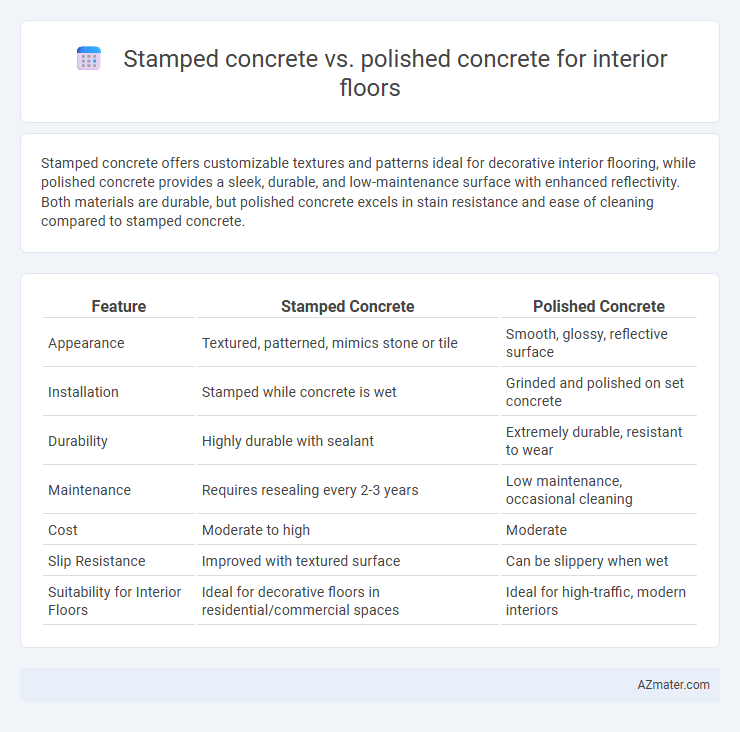Stamped concrete offers customizable textures and patterns ideal for decorative interior flooring, while polished concrete provides a sleek, durable, and low-maintenance surface with enhanced reflectivity. Both materials are durable, but polished concrete excels in stain resistance and ease of cleaning compared to stamped concrete.
Table of Comparison
| Feature | Stamped Concrete | Polished Concrete |
|---|---|---|
| Appearance | Textured, patterned, mimics stone or tile | Smooth, glossy, reflective surface |
| Installation | Stamped while concrete is wet | Grinded and polished on set concrete |
| Durability | Highly durable with sealant | Extremely durable, resistant to wear |
| Maintenance | Requires resealing every 2-3 years | Low maintenance, occasional cleaning |
| Cost | Moderate to high | Moderate |
| Slip Resistance | Improved with textured surface | Can be slippery when wet |
| Suitability for Interior Floors | Ideal for decorative floors in residential/commercial spaces | Ideal for high-traffic, modern interiors |
Introduction to Stamped and Polished Concrete Floors
Stamped concrete offers a durable and decorative flooring solution by imprinting patterns and textures onto freshly poured concrete, mimicking materials like stone, brick, or wood. Polished concrete enhances interior floors through grinding and polishing processes that create a smooth, glossy surface with increased hardness and reflectivity. Both options provide low-maintenance, long-lasting flooring choices, with stamped concrete emphasizing aesthetic variety and polished concrete focusing on sleek, modern finishes.
Core Differences Between Stamped and Polished Concrete
Stamped concrete features textured patterns and designs that mimic natural materials like stone or brick, providing a decorative and customizable flooring option. Polished concrete offers a smooth, shiny surface achieved through grinding and polishing processes, emphasizing durability, low maintenance, and a modern aesthetic. The core difference lies in stamped concrete's ornamental appeal versus polished concrete's sleek, reflective finish suited for high-traffic interior floors.
Aesthetic Appeal: Patterns, Colors, and Finishes
Stamped concrete offers a wide range of aesthetic options with intricate patterns and textures that mimic natural materials like stone, brick, or wood, making it ideal for adding character and visual interest to interior floors. Polished concrete emphasizes a sleek, modern look with a high-gloss finish that enhances the natural colors and aggregates within the slab, providing reflective surfaces that brighten interior spaces. Both options allow for customization in colors and finishes, but stamped concrete excels in decorative variety while polished concrete focuses on smoothness and shine.
Durability and Longevity Comparison
Stamped concrete offers high durability with its textured surface designed to resist cracking and wear, making it suitable for high-traffic interior floors. Polished concrete provides exceptional longevity due to its dense, sealed surface that enhances resistance to stains and abrasion, often lasting decades with minimal maintenance. Both options deliver robust performance, but polished concrete typically outperforms stamped concrete in lifespan, especially in commercial or heavily used interior environments.
Maintenance Requirements for Each Flooring Type
Stamped concrete requires regular sealing every 2-3 years to protect against stains, moisture, and wear, while polished concrete demands periodic dust mopping and occasional re-polishing every 3-5 years to maintain its shine and durability. Both flooring types need prompt spill cleanup, but polished concrete is more resistant to staining and often requires less intensive maintenance. Stamped concrete's textured surface can trap dirt and debris, necessitating more frequent cleaning compared to the smooth, low-porosity finish of polished concrete.
Installation Process Overview
The installation process for stamped concrete involves pouring a concrete slab, followed by applying color hardeners and releasing agents before imprinting patterns with textured stamps while the concrete is still wet. Polished concrete installation requires grinding the concrete surface with progressively finer diamond pads to achieve a smooth, reflective finish, often combined with densifiers to harden the floor. Stamped concrete tends to take longer due to the additional steps of stamping and sealing, while polished concrete focuses on surface preparation and polishing stages.
Cost Considerations: Upfront and Long-Term
Stamped concrete typically has a higher upfront cost due to labor-intensive installation and intricate design patterns, while polished concrete is more budget-friendly initially with lower labor requirements. Long-term maintenance costs for stamped concrete can be higher because it may require periodic resealing and repairs to prevent wear and fading, whereas polished concrete generally offers greater durability and minimal upkeep. Considering lifecycle expenses, polished concrete is often more cost-effective for interior floors in commercial and residential spaces with high foot traffic.
Slip Resistance and Safety Aspects
Stamped concrete offers enhanced slip resistance due to its textured surface patterns, making it a safer choice for interior floors prone to moisture or heavy foot traffic. Polished concrete, with its smooth and glossy finish, can be more slippery when wet, thus requiring additional anti-slip treatments or sealers to improve safety. For interior flooring prioritizing slip resistance and occupant safety, stamped concrete provides a naturally secure surface without compromising aesthetic appeal.
Best Applications: Choosing the Right Concrete for Your Space
Stamped concrete offers intricate patterns and textures ideal for decorative interior flooring in spaces like entryways, retail stores, and themed restaurants where aesthetic appeal is crucial. Polished concrete provides a sleek, durable, and low-maintenance surface perfect for high-traffic commercial settings, offices, and modern residential interiors emphasizing minimalism. Selecting between stamped and polished concrete depends on balancing design preference, durability needs, and maintenance requirements specific to the intended use of the interior space.
Environmental Impact and Sustainability
Stamped concrete often requires more resource-intensive processes, including the use of chemical color hardeners and sealers that may emit volatile organic compounds (VOCs). Polished concrete minimizes waste by enhancing existing concrete surfaces without additional coatings, reducing the need for replacements and maintenance, thus lowering its carbon footprint. Both options offer durable interior flooring solutions, but polished concrete generally aligns better with sustainable construction practices due to its energy efficiency and longevity.

Infographic: Stamped concrete vs Polished concrete for Interior floor
 azmater.com
azmater.com